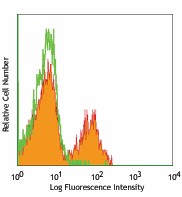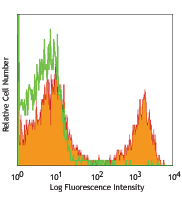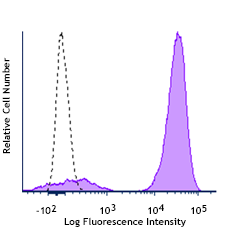- Regulatory Status
- RUO
- Other Names
- Streptavidin-Fluorescein Isothiocyanate, SAv-FITC
- Ave. Rating
- Submit a Review
- Product Citations
- publications

-

C57BL/6 splenocytes stained with 145-2C11 biotin, followed by Sav-FITC
| Cat # | Size | Price | Quantity Check Availability | Save | ||
|---|---|---|---|---|---|---|
| 405201 | 100 µg | 34€ | ||||
| 405202 | 500 µg | 95€ | ||||
Streptavidin binds to biotin with high affinity. Streptavidin-fluorescein isothiocyanate (FITC) is useful for detecting biotinylated antibodies. The excitation of FITC by 488 nm laser light induces a light emission maximum of 520 nm.
Product DetailsProduct Details
- Verified Reactivity
- Human, Mouse, Rat, All Species
- Formulation
- Phosphate-buffered solution, pH 7.2, containing 0.09% sodium azide.
- Preparation
- Streptavidin is conjugated with FITC under optimal conditions.
- Concentration
- 0.5 mg/ml (concentration relates to the Streptavidin only component of the conjugate)
- Storage & Handling
- The Streptavidin-FITC solution should be stored undiluted between 2°C and 8°C, and protected from prolonged exposure to light. Do not freeze.
- Application
-
FC - Quality tested
ICFC - Verified
- Recommended Usage
-
Each lot of this Streptavidin-FITC is quality control tested by immunofluorescent staining with flow cytometric analysis. The concentration provided is based upon molecular mass of streptavidin independent of any additional molecular mass that might be added by the FITC conjugation. For immunofluorescent staining, the recommended use of this reagent is ≤ 0.25 µg per 106 cells in 100 µl staining volume. It is recommended that the reagent be titrated for optimal performance for each application.
- Excitation Laser
-
Blue Laser (488 nm)
- Application Notes
-
Streptavidin-FITC is useful as a second step reagent for indirect immunofluorescent staining, in conjunction with biotinylated primary antibodies. The average molecular weight of Streptavidin-FITC is 60 kD and Streptavidin alone is 52 kD.
- Application References
-
- Schmutz S, et al. 2009. J. Immunol. 183:2217. PubMed
- Cho HY, et al. 2009. Immunol Lett. 127:39. PubMed
- de Wispelaere D, et al. 2012. J. Virol. 86:7072. PubMed
- Fukuoka A, et al. 2013. Int Immunol. PubMed
- Giltiay NV, et al. 2013. J Exp Med. 25:373. PubMed
- Lee JH, et al. 2014. J Rheumatol. 41:2425. PubMed
- Product Citations
-
Antigen Details
- Gene ID
- NA
- Specificity (DOES NOT SHOW ON TDS):
- Biotin
- Specificity Alt (DOES NOT SHOW ON TDS):
- Biotin
- App Abbreviation (DOES NOT SHOW ON TDS):
- FC,ICFC
- UniProt
- View information about Biotin on UniProt.org
 Login / Register
Login / Register 

















Follow Us